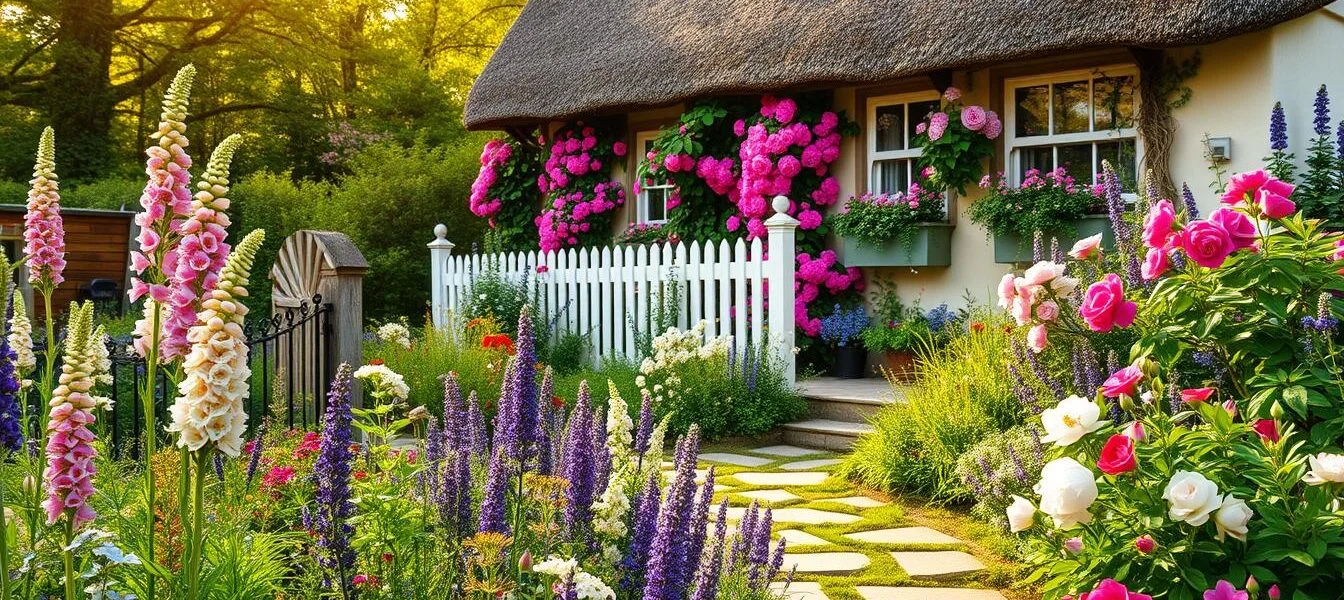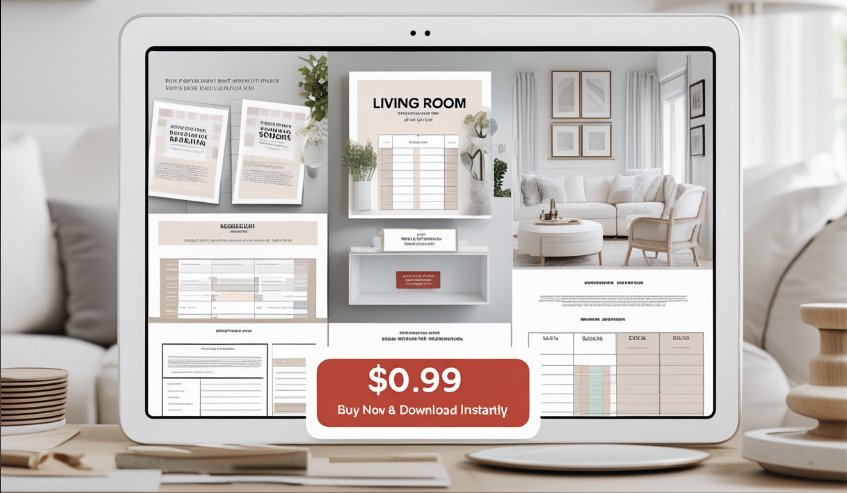Do you dream of a garden full of color, charm, and natural beauty? An English cottage garden might be just what you need. These gardens mix romantic design with practical gardening. They create spaces that feel both wild and beautifully put together.
Your yard can turn into a picturesque retreat, just like traditional English gardens. With lush plants and winding stone paths, an English cottage garden is a magical escape. We’ll show you 15 beautiful ideas to make your outdoor space elegant and timeless.
Whether your yard is small or large, these ideas can make a big difference. The key is to use a relaxed, organic approach. This celebrates nature’s beauty and makes your garden welcoming and intimate.
Key Takeaways
- Discover the timeless charm of English cottage garden design
- Learn how to create a lush, romantic outdoor space
- Transform your yard with natural, layered planting techniques
- Understand the principles of informal garden layouts
- Explore creative ways to blend beauty and functionality
Understanding the Charm of Traditional English Cottage Gardens
Step into the enchanting world of traditional English gardens. Here, beauty and practicality blend in a beautiful landscape. Cottage gardens are a testament to resourcefulness, creativity, and a deep bond with nature, captivating gardeners for centuries.

The history of cottage gardens is tied to the needs of rural families. These gardens started as simple, useful spaces for growing food, herbs, and flowers. They evolved into stunning, romantic landscapes that enchant us all.
Historical Roots of Cottage Gardens
In medieval England, cottage gardens were essential for rural communities. Families used every bit of land, creating layered gardens for:
- Growing vegetables and herbs
- Raising medicinal plants
- Supporting small livestock
- Creating beautiful, useful spaces
“A garden is a lovesome thing, God wot!” – Thomas Edward Brown
Key Elements of English Garden Design
Traditional English cottage gardens are known for their natural, informal beauty. Look for these key features:
- Dense, layered plantings
- Mixed ornamental and edible plants
- Curved, meandering pathways
- Natural stone and wooden structures
The Cottage Garden Philosophy
The cottage garden philosophy is all about working with nature. Your garden becomes a living ecosystem. Plants help each other, creating a sustainable, ever-changing environment.
Essential Plants for Creating Your English Cottage Garden
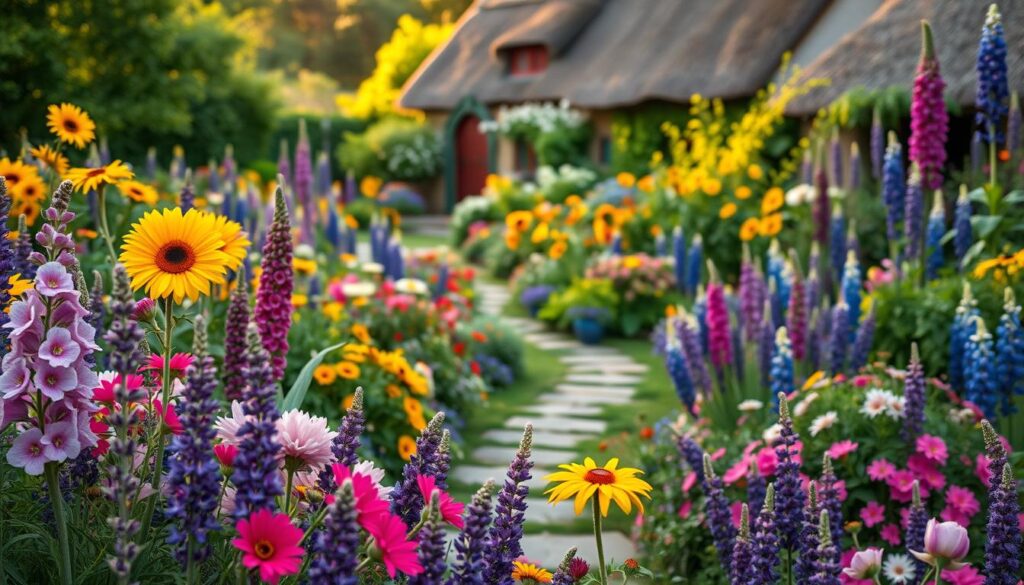
Starting an English cottage garden means picking the right plants. These plants make your garden lush and romantic. Choose English garden flowers that grow well in different climates to make your garden colorful and textured.
Perennial flowers are key to a cottage garden. They come back every year, making your garden change and grow. Here are some great choices:
- Delphinium – Tall, stunning blue spikes that add vertical interest
- Foxgloves – Elegant, bell-shaped flowers perfect for shaded areas
- Hollyhocks – Classic cottage garden staples with dramatic height
- Lavender – Fragrant purple blooms that attract pollinators
- Peonies – Luxurious, full-bodied flowers in soft pastel shades
When picking perennial flowers, think about your climate and sunlight. Use tall plants in the back and shorter ones up front. Mix colors that look good together and bloom all season.
A good cottage garden is both structured and wild. Let your plants mix and grow freely. Use different heights, textures, and bloom times to keep your garden lively all year.
Designing Meandering Pathways and Garden Borders
Creating enchanting garden pathways is key to a beautiful cottage garden. Your natural stone paths can turn an ordinary yard into a magical place. They invite exploration and wonder.
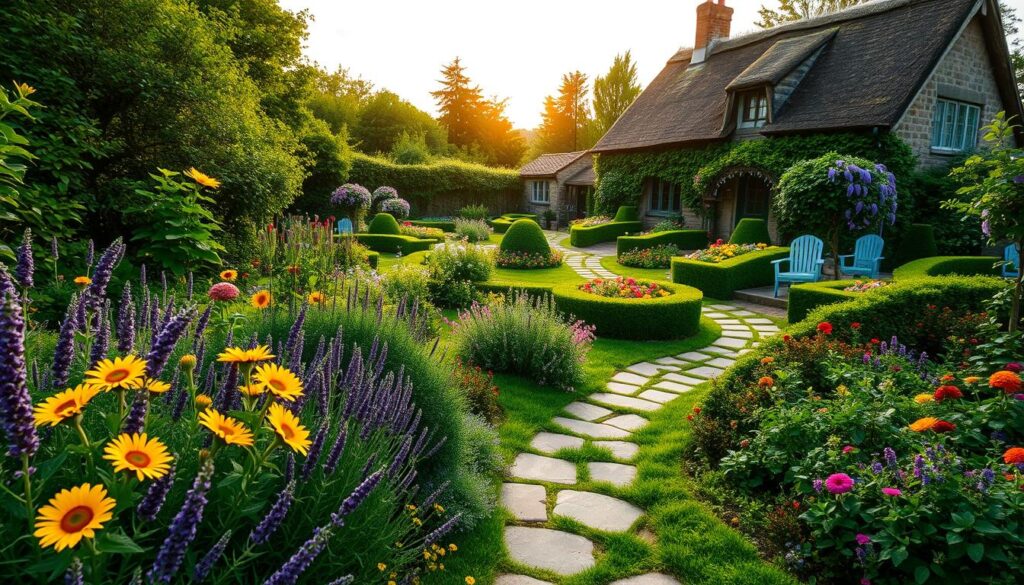
Designing cottage garden borders needs careful planning and creativity. The goal is to create layers that add depth and texture. Your garden borders should feel organic and a bit wild, like a classic English cottage garden.
Natural Stone Path Options
When picking natural stone paths for your cottage garden, consider these top options:
- Flagstone: Provides a rustic, irregular appearance
- Slate: Offers rich color variations and durability
- Limestone: Creates a soft, elegant pathway
- River rocks: Adds a natural, meandering feel
Border Planning and Layout
Successful cottage garden borders mix structure with spontaneity. Plant taller perennials in the back, medium-height plants in the middle, and shorter plants or ground covers in the front. This creates visual depth.
| Border Layer | Plant Height | Recommended Plants |
|---|---|---|
| Back Layer | 3-6 feet | Delphiniums, Hollyhocks |
| Middle Layer | 1-3 feet | Lavender, Geraniums |
| Front Layer | 6-12 inches | Thyme, Alyssum |
Mixing Materials for Visual Interest
Make your garden pathways dynamic by mixing materials. Combine natural stone paths with gravel, brick accents, or wooden stepping stones. This adds texture and character to your cottage garden borders.
The goal is to design a garden pathway that feels intentionally unintentional. It should be inviting, organic, and full of charm.
Incorporating Climbing Roses and Flowering Vines
Vertical garden elements turn simple spaces into magical English cottage gardens. Climbing roses and flowering vines add height, texture, and romance to your outdoor space.
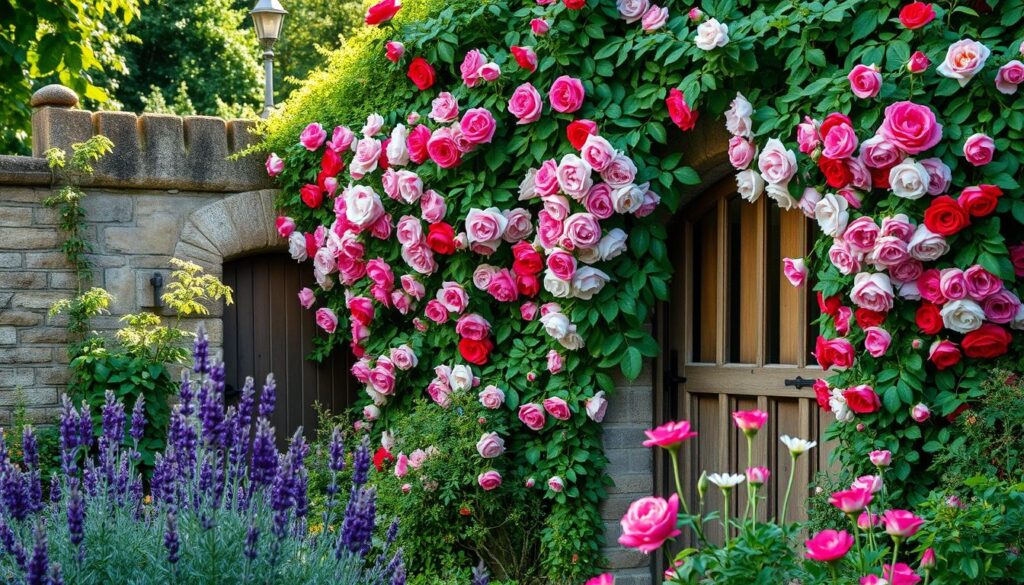
When picking climbing roses, choose ones that do well in your area’s climate. Some beautiful choices include:
- David Austin’s ‘Graham Thomas’ – Rich yellow blooms
- Zephirine Drouhin – Vibrant pink climbing rose
- New Dawn – Soft blush-colored classic climber
Flowering vines add depth to your garden, making it more interesting. Use them to create different areas and natural privacy screens.
| Vine Type | Sun Requirement | Bloom Color |
|---|---|---|
| Clematis | Partial to Full Sun | Purple, Pink, White |
| Wisteria | Full Sun | Lavender, Blue |
| Honeysuckle | Full Sun to Partial Shade | Yellow, Red |
It’s important to have strong support for climbing roses and vines. Choose sturdy trellises, arches, and pergolas that look good and hold up well.
“A garden without climbing roses is like a story without poetry.” – Unknown Garden Enthuasiast
Learning to train and prune your plants is key. Regularly guide your vines and remove dead or tangled branches. This helps them grow strong and bloom well.
15 English Cottage Garden Ideas to Transform Your Garden with Natural Beauty
Creating a stunning cottage garden is an art that blends natural beauty with thoughtful design. These cottage garden ideas will help you transform your outdoor space into a vibrant, living canvas that captures the essence of traditional English garden charm.

Cottage gardens are all about embracing a relaxed, organic approach to landscaping. Your garden should feel alive with color, texture, and seasonal interest that evolves throughout the year.
Seasonal Planting Strategies
Successful seasonal planting is the heart of natural garden beauty. Consider these key approaches:
- Create layers of plants that bloom at different times
- Mix perennials with self-seeding annuals
- Plan for continuous color from early spring to late fall
Color Coordination Tips
Harmonizing colors can elevate your cottage garden design. Try these strategies:
- Choose a soft, romantic color palette
- Use complementary flower colors
- Create visual depth with varying flower heights
| Season | Recommended Colors | Key Plants |
|---|---|---|
| Spring | Soft Pastels | Tulips, Peonies |
| Summer | Vibrant Jewel Tones | Roses, Delphinium |
| Fall | Warm Earth Tones | Chrysanthemums, Asters |
Maintenance Guidelines
Keeping your cottage garden looking its best requires consistent care. Embrace a slightly wild aesthetic, but don’t let it become completely untamed.
- Prune regularly to encourage healthy growth
- Mulch to retain moisture and suppress weeds
- Allow some plants to self-seed for natural regeneration
Remember, the beauty of cottage garden ideas lies in their personal touch. Your garden should reflect your unique style while celebrating the natural beauty of carefully selected seasonal planting.
Creating Cozy Garden Seating Areas and Focal Points
Turn your outdoor spaces into magical retreats, like a classic English cottage garden. Garden seating areas are more than just places to sit. They’re artistic spots that invite you to relax and connect with nature.
When setting up cottage garden focal points, remember these important points:
- Opt for rustic seating that fits right in with nature
- Make cozy nooks with the right plant choices
- Add vintage garden ornaments as eye-catching features
- Frame your seating with climbing roses or vines
Your garden seating area should feel like a secret hideaway. Vintage wrought iron benches, weathered wooden chairs, and charming bistro sets can make your outdoor area look amazing.
| Seating Type | Best Location | Style Impact |
|---|---|---|
| Stone Bench | Near Rose Borders | Classic Cottage Charm |
| Wooden Chairs | Herb Garden Corner | Rustic Warmth |
| Wrought Iron Bistro Set | Garden Path Intersection | Romantic Elegance |
Placing cottage garden focal points wisely can lead visitors through your garden. It creates a sense of adventure and wonder. Adding a sundial, birdbath, or sculpture can catch the eye and add interest.
Sustainable Water Features and Bird-Friendly Elements
Creating a harmonious garden ecosystem is more than just about plants. Adding garden water features and bird-friendly designs turns your outdoor space into a lively, living landscape. It supports local wildlife and makes your cottage garden look even better.
Adding sustainable elements to your garden is good for the environment and fun. Eco-friendly gardening practices help create a home for birds, beneficial insects, and other wildlife.
Types of Garden Water Features
When picking water features for your cottage garden, look for ones that are both beautiful and support wildlife:
- Small recirculating fountains
- Shallow birdbaths with textured surfaces
- Compact pond installations
- Rock-based water cascades
Attracting Local Wildlife
To make a bird-friendly garden, you need to plan carefully. Create spaces that offer shelter, water, and food for local birds.
| Wildlife Attraction Strategy | Benefit |
|---|---|
| Native plant selection | Provides natural food and shelter |
| Water feature placement | Offers drinking and bathing opportunities |
| Varied landscape zones | Supports diverse wildlife habitats |
Eco-Friendly Garden Practices
Use sustainable techniques to help your garden’s ecosystem:
- Collect rainwater for irrigation
- Use organic composting methods
- Avoid chemical pesticides
- Plant native species
By designing garden water features and using bird-friendly practices, you’ll make a dynamic, sustainable outdoor space. It will nurture wildlife and your connection to nature.
Mixing Ornamental and Edible Plants in Your Design
Turn your garden into a lively, useful area with edible landscaping. The art of designing a kitchen garden is more than just growing veggies. It’s about making a beautiful, useful outdoor space that pleases the eye and the taste buds.
Ornamental vegetables are a clever choice for gardeners. They look great with flowers, adding texture, color, and usefulness to your garden. Here are some beautiful edible options:
- Rainbow Swiss chard with its vibrant stems
- Purple-leafed kale as a dramatic border plant
- Bright red lettuce varieties
- Climbing beans with decorative flowers
Companion planting elevates your garden design. By placing herbs and veggies among flowers, you get a beautiful look and pest control. Marigolds, for example, keep pests away while adding golden color.
“In a well-designed garden, every plant serves multiple purposes – beauty, food, and ecological balance.” – Garden Design Expert
Your kitchen garden can be both useful and beautiful. Mixing ornamental and edible plants makes a lively landscape. It gives you fresh food, helps local wildlife, and turns your outdoor area into a stunning, productive space.
Year-Round Interest: Planning for Four-Season Beauty
To create a four-season garden, you need to plan and choose plants wisely. Your cottage garden can be a lively spot all year, even in the cold.
Turning your garden into a year-round beauty means knowing how plants add interest in winter and during seasonal changes.
Crafting Winter Garden Structure
Winter doesn’t have to be dull. With smart gardening, your garden can stay beautiful even when it’s cold:
- Plant evergreen shrubs like boxwood and holly
- Incorporate ornamental grasses with interesting seed heads
- Use architectural elements like trellises and stone sculptures
- Select plants with interesting bark textures
Spring Bulb Planning for Vibrant Awakening
Spring bulb planning brings life back to your garden with little effort. Think about planting:
- Daffodils
- Tulips
- Crocus
- Snowdrops
Spread these bulbs in groups for a natural, cottage garden-inspired look. Plant them in autumn for a beautiful spring show.
Seamless Seasonal Transitions
Design your garden to smoothly move from summer to fall. Pick plants that bloom for a long time and have colors that go well together. Think about perennials like:
- Echinacea
- Black-eyed Susans
- Sedum
- Ornamental grasses
By picking plants that bloom at different times, your garden will stay lively and interesting all year.
Conclusion
Starting an English garden style can make your outdoor area magical. The cottage garden style is very flexible. It lets you create a space that shows off your taste and fits your area.
Your garden design tips from this guide will help you make a lively, changing outdoor space. It will grow and change with the seasons.
Every cottage garden has its own story, thanks to the plants, paths, and cozy spots. By using organic design and mixing plants for looks and food, you’ll connect with nature. Start small, try out different looks, and let your garden grow naturally.
Your garden journey is ongoing, not just a one-time thing. Every plant, path, and spot adds to your garden’s charm. With time and creativity, your garden will not only look great but also be a peaceful place for you to relax and enjoy.
When you start your cottage garden, trust your ideas and have fun. Your garden will show off your creativity and be a changing sanctuary for years to come.
FAQ
What defines an authentic English cottage garden?
An English cottage garden is full of plants, with a mix of pretty and useful ones. It has winding paths and a natural feel. You’ll see lots of plants, climbing roses, and flowers like hollyhocks and delphiniums.It looks lived-in and focuses on beauty and use. It’s not about being perfect.
How can I create a cottage garden in a small space?
You can make a cottage garden small by using vertical gardening. Try climbing plants and wall planters. Layer your plants to add depth.Choose small versions of cottage garden plants. Use containers and mix heights and textures. Add things like herb gardens and small fruit trees to make the most of your space.
What are the best plants for a low-maintenance cottage garden?
For a garden that’s easy to care for, pick plants like lavender and catmint. They don’t need much water and look good for a long time. Native plants are also great because they fit in well and need little help.
How do I incorporate edible plants into my cottage garden design?
Mix veggies and herbs with flowers for a pretty and useful garden. Plant colorful veggies like rainbow chard with flowers. Use herbs as borders and add fruit trees or bushes for structure.This way, your garden is both beautiful and productive, just like a traditional cottage garden.
What are some budget-friendly ways to create a cottage garden?
Start by growing plants from cuttings or seeds. Use old materials for paths and structures. Look for plants at local sales or in clearance sections.Choose plants that spread and accept divisions. Aim for a natural, layered look without spending a lot.
How can I make my cottage garden wildlife-friendly?
Make your garden friendly to wildlife by planting native flowers and leaving some areas wild. Add water sources like birdbaths. Include plants that attract bees and butterflies.Use natural materials for paths and avoid chemicals. Native plants and diverse plantings help local wildlife.
What are the best materials for cottage garden pathways?
Use natural materials like gravel, old brick, or stone for paths. These give a rustic look that fits the garden’s style. Mix materials for interest and drainage.Soft, winding paths that blend with the plants are key to the cottage garden look.
How do I maintain the informal look of a cottage garden?
Keep your garden informal by letting plants grow a bit wild. Don’t prune too much and let borders grow. Use plants that mix well and accept some mess.Focus on a natural, harmonious landscape. It’s more important than a perfect, manicured garden.
